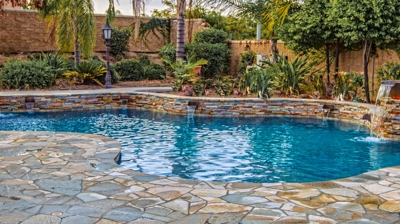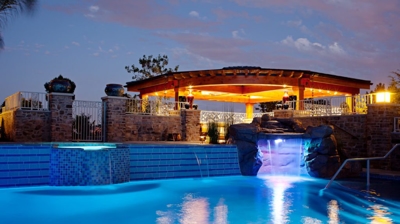Summer is coming, and your thoughts may be turning towards pool maintenance, repair, and remodeling. One of the most common ways to refresh your backyard and improve your experience is through pool resurfacing. A standard aspect of pool care, the process involves removing and replacing the original sealant. Read on to learn when it’s necessary and how to budget for pool refinishing costs.
How to Estimate Pool Refinishing Cost
Pool resurfacing is a standard industry practice, and experienced companies will be able to provide you with an accurate idea of approximate refinishing costs using common materials. Besides labor costs, an estimate will take the following four factors into account:
- The size of the pool
- The current condition of the surface
- The need for crack or leak repair
- The finishing material selected
What Is Pool Refinishing?
Before you get started on any home or pool repair, you should research the process and the price tag. You’ll then know what to expect, and if you have any concerns throughout the process, you’ll be a more informed consumer. So, what is pool refinishing?
Also called resurfacing, refinishing is a regular maintenance process that involves removing and replacing the top layer of the pool surface. With a smooth, rejuvenated surface and any cracks or leaks repaired, the pool is ready for a new sealant. The completed process results in a pool ready for years of use, with all the luster you loved when you first installed it.
How to Know if Your Pool Needs Resurfacing
As a pool owner, you’re familiar with the importance of maintenance. Ideally, the company installing the pool should provide a guide to how to take care of it. Since pools differ in terms of sealant types, the regularity of resurfacing also varies. If you are unsure of how frequently your pool needs this type of repair, first check with your pool installation company and any printed materials they provide.
Before you worry about pool refinishing costs, find out if you even need to go down that route. Look for a few telltale signs, which vary depending on the type of finish used. Perhaps the most common red flags are chips, cracks, and rough textures, as well as visible leaks. Problems such as water level issues and persistent residue could also point to the need for refinishing. Stains and discoloration in tiles or tinted plaster are other signs.
Remember, if you aren’t sure, have a professional evaluate your pool. Refinishing is essential maintenance, and putting it off could cost you more money in the long run.
Related: 5 Telltale Signs It’s Time for a Pool Renovation
Choosing a Finishing Material
Several different types of pool resurfacing materials are on the market, each with its technical requirements, pros and cons, and price. Your first step is to determine what type of pool you have. Is it concrete, fiberglass, or vinyl-lined?
Resurfacing for concrete and fiberglass pools is similar, and most finishing materials apply to both. Vinyl pools, however, require a different process, which doesn’t include additional materials like those discussed below.
Three of the most common finishing materials are plaster, quartz, and pebble.
Pool Refinishing Cost with Plaster
Plaster is the most classic pool finish, and it remains a popular choice due to its lower price point. It may be your best option if you have a large pool or don’t have the budget to invest in other, more expensive types of finishes.
White plaster lends the classic pale blue color to your pool, but it also stains easily. One alternative is tinted plaster, which has the added benefit of increasing dimension and enhancing the pool’s reflection.
When deciding which finish selecting, it’s important to consider the cost of both the current repair and future maintenance. One strike against plaster is its shorter lifespan when compared to the others, meaning it will need replacement sooner. This future cost also applies to labor and the inconvenience of having to drain and refill your pool, crews in your backyard, and no access to your pool for a period of time.
Do you have a fiberglass pool? Plaster is not an option, then. Additionally, some people find its texture rough and coarse, so it may not be an ideal choice for those with sensitive skin.
Cost to resurface with white plaster: Approximately $4 per square foot
Average lifespan: 7 years
Pool Refinishing Cost with Quartz Finish
Quartz, also known as aggregate, is a mixture of concrete and crushed quartz, which is dyed and smoothed over the pool structure. This finish has been used for decades and has many positive points in its favor.
Quartz is extremely strong—stronger than steel, in fact, making this finish durable for years. It’s also attractive since the mineral gives it a shine that creates lovely reflections in the pool water. Quartz is also stain-resistant and available in a variety of colors.
Because of its texture, some people find this finish hard to walk on, so one option is to add white plaster to the mixture. This variation can mitigate the issue but at an increased price.
The average lifespan of a quartz finish is around 15 years, which is comparable to a pebble.
Cost to resurface with quartz (aggregate): Approximately $5 per square foot
Average lifespan: 15 years
Pool Refinishing Cost with Pebble Finish
Pebble finish is a specialized aggregate incorporating tiny rocks. Once applied, the pool builder polishes it, resulting in a smooth, reflective surface that makes it a luxurious option for any swimming pool.
The textured pebbles add traction, providing an additional element of safety. They also create visual interest and allow for custom designs. Pebbles are available in a variety of different colors and sizes, so you’ll be able to choose a style that works with your home and backyard design. This finish is also more stain-resistant than the other two options.
This type of finish is durable and long-lasting, with an average lifespan of 20 years. When it comes to pool refinishing costs, pebble is the most expensive of the three, but it makes an ideal choice for those who value durability and beauty over cost.
Cost to resurface with pebbles: Approximately $10 per square foot
Average lifespan: 20 years
Related: Contractor or DIY: What Are Your Pool Deck Resurfacing Options?
Resurfacing and Remodeling
If you’re already paying for the pool refinishing cost, you might want to consider a renovation, as well. With your pool already out of service, a pool remodel can be good a two-for-one in terms of time management. If you have the budget available for a renovation, consider a few of the following ways to update and improve your existing pool:
- Refinishing the deck with modern decking
- Adding pool heating
- Incorporating water features or a slide
- Installing lights or water jets
- Updating the landscaping
You can even change the shape of the pool, add steps, or incorporate a hot tub. The options you choose will contribute to the overall cost of any remodeling attempt, so be sure to focus first on the pool refinishing costs and then go from there.
Now that you know more about pool refinishing, you can decide how it fits into your home maintenance budget and plans. The next step is to speak with a professional who will be able to walk you through the process and discuss finishes, application methods, time estimates, and other technical seo issues.
At California Pools, we have experience in every aspect of pool ownership, including pool resurfacing. Contact us to arrange for a pool refinishing consultation.
.jpg)


